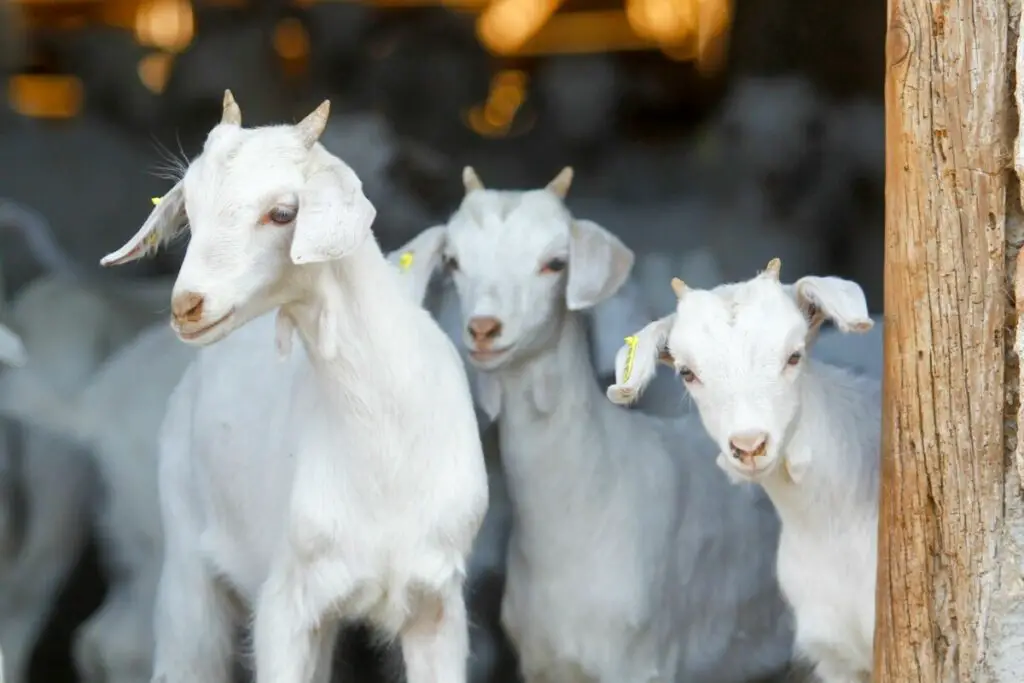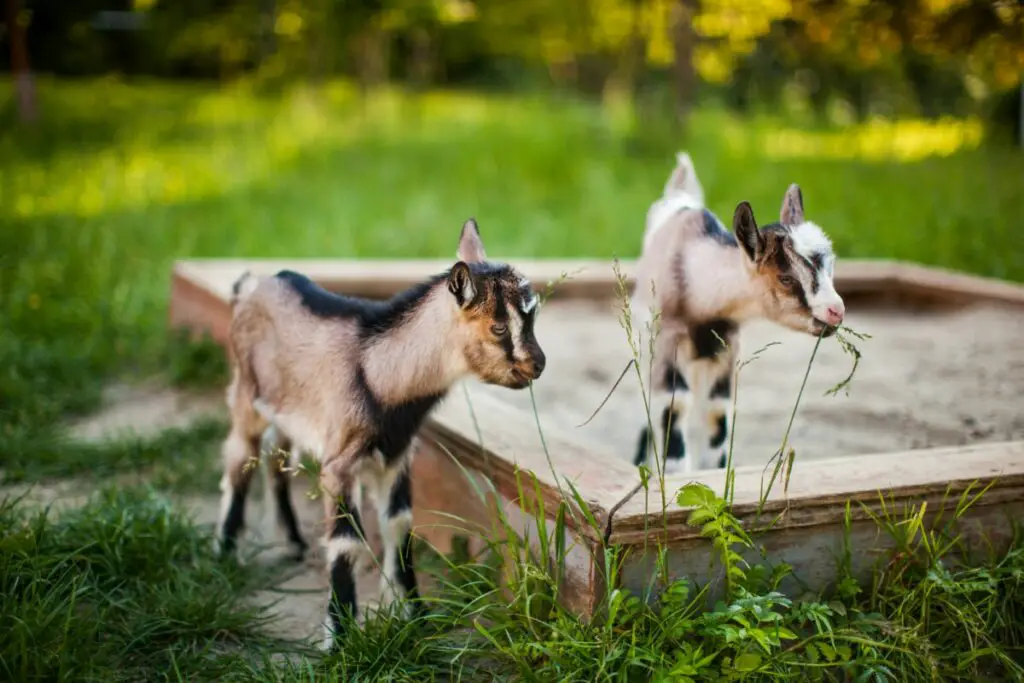
Owning any kind of pet is a joy for many. However, owning a pet is only half the fun, the other half involves potty-training them and perfecting their behavior. If you are wondering if it’s possible to house-train a goat, keep reading!
Goats can be house-trained. House training a goat is simple if one has the right tools. Though they can be house-trained, goats display challenges unlike other domestic animals such as not properly signaling when they need to go to the bathroom. Also, keep in mind that goats are stubborn.
In this article, we will explore how house training a goat can be easy and challenging. We will also note when it is the best time to start house training them and what kind of goats may learn quicker than others. Let’s go ahead and learn whether it is possible to house-train a goat and if it’s worth the effort.
House Training Goats Like Other Pets
When it comes to training in general, goats are just any other domestic animal such as a cat or dog that can be easily trained with patience and consistency. The same methods used for other animals are applicable to goats. However, you will need to pay careful attention to what the goats do considering the goat’s nature to be intelligent but extremely curious at the same.
For example, when entering into a new space, the curiosity of the goat will be immense, and every nook and cranny will be explored to its fullest. You may think that this is a good thing in that allowing the goat to explore will become familiar with its surrounding. You’d be right, however, because of this new environment, every new location discovered has the potential to be used as a bathroom. For goats, it is hard to pinpoint when they need to urinate or defecate.
In contrast, cats and dogs will learn where exactly they need to urinate or defecate. If trained well and consistently, they will go to the same spot consistently. Regardless of the new environment, cats and dogs know well where they are allowed to go to the bathroom and where they are not allowed to do so.
Goats have sporadic minds, and their naturally destructive tendencies may create unnecessary, new locations to urinate or defecate. They may also display indecisive actions such as going to one place and then another shortly after. Since their minds are sporadic, they are unpredictable in how they behave, so it is vital to keep a close eye on them throughout the house-training process.
Overall, goats are capable of being trained using the same methods that would be used to train cats and dogs. Goats, however, need extra attention in order to effectively house train them.
Creating a Bathroom Area

Now that we have briefly discussed the idea that goats can be house-trained like any other domestic animal, let’s now go into the process of properly preparing a location, house-training a goat, and learning about any precautions that are necessary due to the nature of the goat.
As we have said earlier, goats are intelligent and curious creatures that need to explore and learn about the environment for themselves. This means allowing the goat to explore everything. Despite the potentially negative effects of doing this, when granting the goat freedom to wander around the home, I think it is best for it to explore first.
In doing so, one should plan ahead for this. This means removing any items of value out of the goat’s way. The reason I would recommend this is that in order to train a goat, you need to be aware of the goat’s natural tendencies and routine. Working around the goat’s preference at first is best. If the goat has been crowding around a particular area, build your house training around that area.
If the goat is conveniently settling around an area you desire, block off that area and make sure all existing outlets and breakers are turned off and/or removed. If not, make temporary changes to that area for now until you can find a new method of transferring the goat to a more desired location.
Since goats thrive in wide-roaming areas, decorate the area that simulates it such as removing items that would hinder the goat’s free-roaming movements and provide amenities such as hay. You may also want to add a type of litter box, as you will likely be training them to use it. Again, they will be stubborn at following commands at first, so be patient. Eventually, the litter box will be used.
Once the area is set up for use and proper training, it is now time to house-train your goat. Again, if we want to properly house-train a goat, we have to set up a dedicated location for this purpose. Training a goat outside a dedicated location will continue to complicate things, as anywhere and everywhere is fair game for the goat.
What is the Best Age to House Train a Goat?
As we begin with the house-training process, we should understand what time is best to train a goat. That is, what age is optimal for house training?
As with any animal and human, the younger they are house trained, the better. The younger they are, the more receptive to commands they tend to be, making house training a cinch.
If they are on the older spectrum (about 2 years), they will display the stubbornness previously mentioned, making it extremely difficult to have the goat cooperate effectively. Once the goat has established its habits, it is hard to have it break from such habits, so it is important to know your goat’s age and build your training plan from that.
Use Water or Commands to Prevent Bad Habits

When dealing with any goats and their natural tendencies, it is always best to use a spray bottle or something similar to deter any habits. Harmless substances like water are best for spraying purposes. Much like other domestic animals, a quick spray in the face or body will create an unpleasant stimulation and make your goat react aggressively or passively. Note that we mean aggressive not in terms of physical aggression, but in a pouty mood.
Headbutting and chewing, for example, are destructive habits that your goat will inevitably develop throughout their lifetime, so finding a method to significantly reduce these behaviors is the goal. With house training, using the spray to inflict a non-physical punishment when the goat decides to urinate or defecate in an undesired area could help mitigate the frequency of it happening.
You may need to deal with the goat going to the bathroom in that same area over time before it gets the idea that it should not use the bathroom there. Again, patience is key, so be prepared to deal with the goat’s mischief or a bit.
Though I personally would prefer using a spray, you may instead use basic verbal commands or a combination of spray and verbal commandments. Verbal commands can be in form of reprimands such as, “no,” “bad,” and other verbal commands that insinuate the bad habit should stop or be redirected.
Using these verbal reprimands in combination with the spray bottle may be useful in intensifying the method of a deterrent, but they shouldn’t be used too much, or they could backfire.
Housebreaking Method
Housebreaking is a potty-training method for outside. Though this article is focused on house training, it doesn’t mean that it should only be trained to do its business indoors, rather, it is focused on proper bathroom habits for outdoor use as well. If your goat has access to an outside door, teaching your goat to signal and be let outside for bathroom breaks is excellent.
This will only apply if you do not want the goat to urinate or defecate indoors but want the goat to remain inside. Other purposes can be adding an additional area for the goat to use instead of the designated one indoors, creating a flexible convenience for the goat. You may consider a traditional flap door to the outside for ease of access and without requiring the owner to be present to open the door.
Overall, housebreaking is an excellent choice for goats who can gain outside access to do their business and avoid an accumulation of stench and stains within the home and may allow the goat to feel at home when exposed to a more natural environment compared to an artificial one.
Verbal and Food Rewards

If there is anything that all humans and animals will work for, it is rewards of all kinds. Whether it is verbal or physical, we all yearn for validation for our successful efforts. This habit of being rewarded for our successful efforts and then being motivated to further such efforts for future rewards is also known as operant conditioning.
With operant conditioning, we are wanting to increase the frequency of the behavior whether it’s positive or negative. For example, we will reward a child when they stop yelling indoors or receives a B grade in the class. One focuses on an increase in behavior via decreasing a negative one (yelling), while the other is focused on increasing future efforts to achieve a B grade or higher.
In our case, house training a goat will involve the same gratification. We will reward the goat for doing desired behaviors and decreasing undesired ones.
For example, if the goat decreases its bathroom habits in an undesired area, we will reward the goat with food and/or verbal affirmation. Food is by far the most incentivized object a goat will seek as they are naturally seeking food. One should prioritize food as a reward system, as that will most likely get the goat doing the things we want it to do.
Verbal affirmations such as “good boy/girl,” “great job,” or “well done,” all can be useful in combination with food rewards. They do not have the strongest impact compared to food but are worth using regardless.
Note that for both verbal and food rewards to work effectively, you must be quick to respond to either positive or negative behaviors and reward or punish accordingly. If your response time is heavily delayed, rewarding or punishing the goat will be confusing, since a new behavior would be present, and they would think that you are praising their current behavior, not their previous one.
For example, if the goat urinates in the litter box, you must reward it immediately, before the goat does something else like headbutting. If you delay in that case, you would be rewarding the headbutting rather than the usage of the litter box. In this case, only reward behaviors and actions that enhance the house-training process.
Consistency is Key

To conclude this article, we need to know that keeping a set and consistent schedule is vital. This includes rewarding and punishing accordingly, and reminding the goat what it should do, as goats tend to remain naturally sporadic throughout their lifetime.
If one decides to deviate from a consistent schedule, then all efforts to house-train the goat will be all for nothing. A single success from the goat does not mean it will do this forever. Upkeep of rewards and punishments must be maintained long-term to keep the goat going where it needs to go. Lack of any of these things means the goat will either be frustrated that it isn’t being rewarded for the things that were previously rewarded, or it may think it can now get away with anything since punishment isn’t being inflicted.
Goats will change their minds, and if not controlled, they will return to their usual habits. When house training a goat, you are there for the long run and must be dedicated.
Overall, goats are fantastic animals to be kept as pets. Be wary that because of the natural tendencies, they will be challenging to house train. It isn’t impossible, it just takes additional effort to get them to the point of consistent success as compared to other domestic animals.


